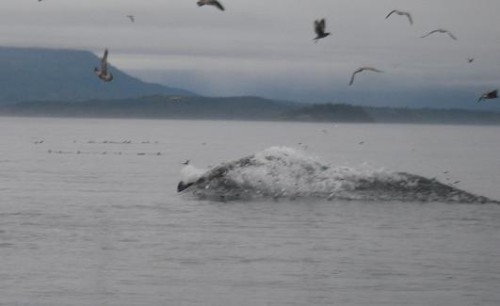
This post ties in with the posts on June 21st and 22nd. Only in this case it is hard to determine that there is a humpback whale beneath the spray of herring.

This post ties in with the posts on June 21st and 22nd. Only in this case it is hard to determine that there is a humpback whale beneath the spray of herring.
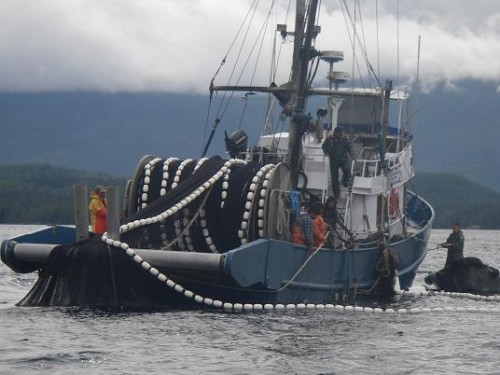
Eagles, grizzly bears, sea lions, killer whales and humpback whales are not the only thing we watch trying to catch salmon on our wildlife trips. Their are also sports fishermen and in this case commercial fishermen. This boat is the Ocean Predator which works for the Department of Fisheries doing “test sets” to determine if there are enough salmon in the area to have an “opening” for a commercial fish. We watched them do a quick count of the number and variety of salmon in this set. About seventy-five salmon means there will not be an opening for a while.
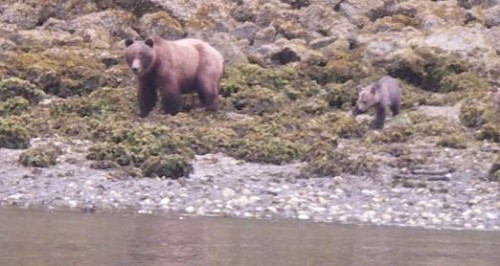
We have been spotted by the mother grizzly and her cub and in turn they are easier to see on the beach. Heads up and looking in our direction make them much more noticeable than in yesterday’s post.
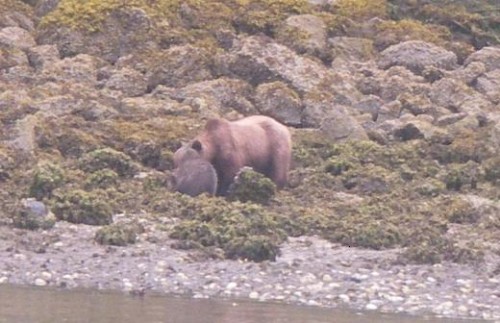
From a greater distance and if they are not moving grizzly bears tend to blend in with the rocks on the beach. Both bears seem to have found something worthy of their full attention but that is what happens when mother turns over a rock. This inter-tidal zone “food” is high in protein and is made up of crab, clams, barnacles, amphipods and other tiny invertebrates. The “beach food” is important because plant food is relatively scarce during spring and bears will continue to loose weight until well into June.
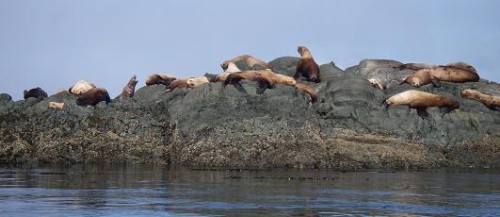
It is a nice place for watching wildlife but I would not want to have our picnic lunch to close to the Steller sea lions. There are a few sea lions that remain in our area all year but there are definitely more in the spring and fall during their migration between Alaska and California. The noise and aroma are enough to make sure that we are at least upwind in a quieter location for lunch.
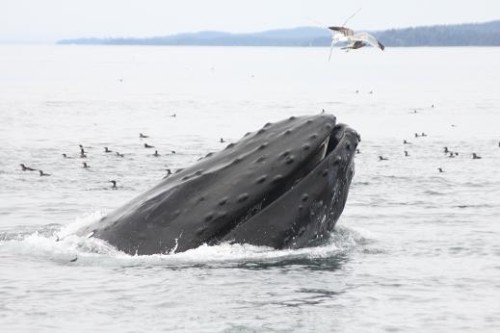
On most days whale watching we have opportunities to obtain both the active and the sedate photos. It is all a matter of being able to position the boat to get the best photo. The only problem is that the whales do not always agree with the guide as to what is the best position so it may take several tries.
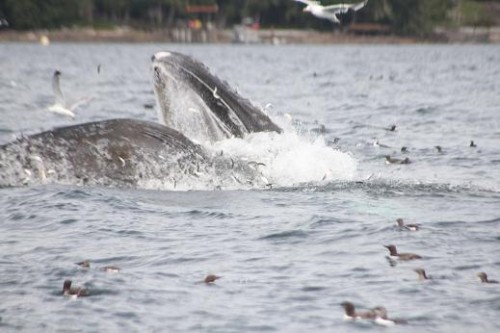
A very action filled photo with a humpback whale lunge feeding on a ball of herring. One can see the herring being sprayed out of it’s mouth and seagulls coming into pick up the wounded herring. But it is really hard to picture this as a whale feeding whereas tomorrows post is more sedate….
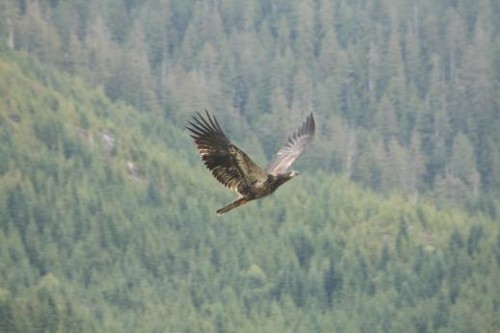
This first year bald eagle is flying high over the area on Knight Inlet’s Glendale River where we watch grizzly bears from viewing platforms. The eagles are in the area for the same reason that the bears come to the river – salmon. The spawning cycle of the salmon attract grizzly bears, black bears, eagles, seagulls and wolves to the river valleys. Wolves are seldom viewed but the rest are in abundance. In this case the eagle is looking for a salmon carcass to scavenge as this is much easier than catching you own.
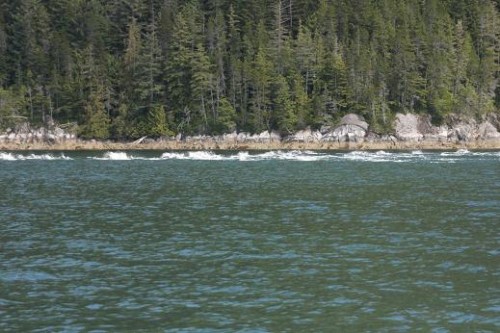
These two photos show some thing that is pretty obvious but if you are much further away it is hard to tell what is making the white water. Pacific white sided dolphins may travel in pods of twenty-five to over one thousand. In either case they seem to like playing with a moving boat. After guest spend time with the dolphins it is hard to make their day get any better but we keep trying.
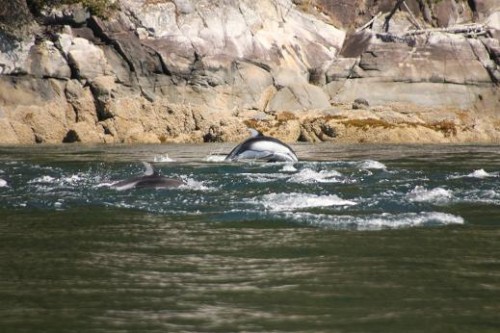
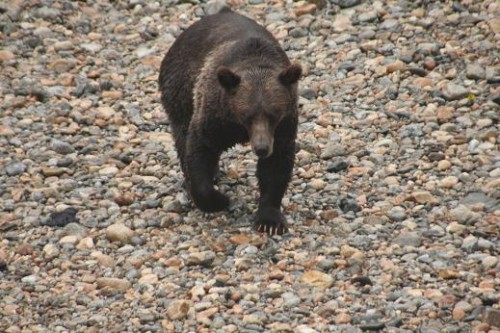
.. as large male grizzly comes around the same corner toward the stands. Normally when the large males come to fish the other grizzlies back off the fishing area but on this day they did share even if the mother and cubs did keep a respectful distance.

Just like that our season has come to an end. I would like to thank all of our wonderful guests and staff who made this year a huge success. I am happy to stay that all of our team is planning to return next season. We are actively taking bookings, with dates starting June 1 2025. Hope to see many of you next season.
The wildlife viewing this season was awesome. A couple highlights that come to mind was the shear number of salmon in our local rivers, as well as the abundance of Resident Orca. With salmon returns being so strong this year, we were happy to see bears in excellent condition. By the end of our season most of the bears had packed on a lot of weight and were getting very “picky” about what parts of the salmon they would eat. Hopefully this will translate into more cubs being born this winter. Another positive was the weather conditions. We had enough rain to keep our fire risks low and it made for some excellent wild berries. The bears took full advantage of this, with the berry season extending far past its normal conclusion. This did mean that we had to work hard to find bears during our summer season, (as they were often feeding on the berries deep into the forest), but moving forward it is excellent that they had such an abundant food supply. The Humpbacks also didn’t disappoint, with great numbers and a few new calves returning with their mothers to feed. After a slower year for resident Orca sightings, this season was one of the best that I can remember. In fact as Im writing this the A62 and A23’s are still being spotted in the area by dedicated biologists. Strong numbers of Chinook and Chum salmon are providing them with a steady food source. There are a lot of positive signs and we are hopeful that 2025 will be another great season.
Over the winter and spring we will be doing some repairs and maintenance. We plan on having a new cedar front deck built in time for the 2025 season, as well as new ceilings and paint in parts of the lodge and rooms. Theres always projects on the go.
Felix, Julien, Ryan, Zack and Myself all look forward to welcoming guest in June. See everyone soon.
Angus Reid
Visit our Blog